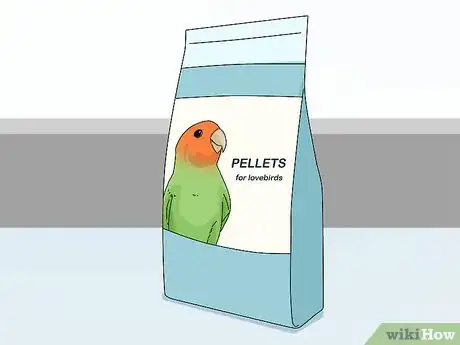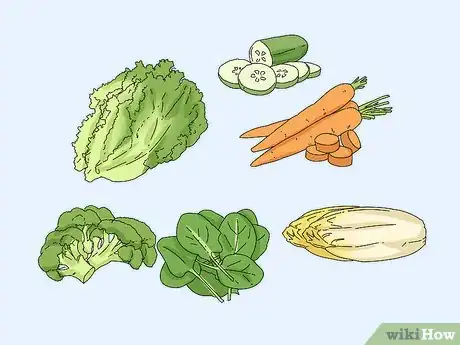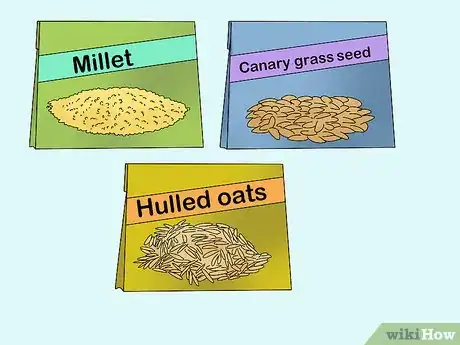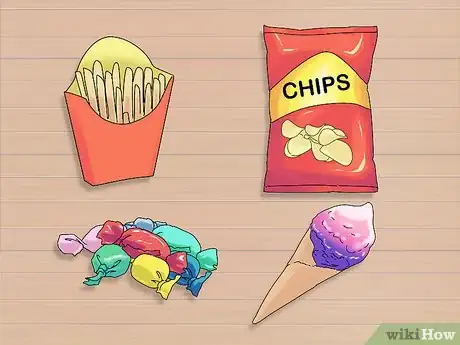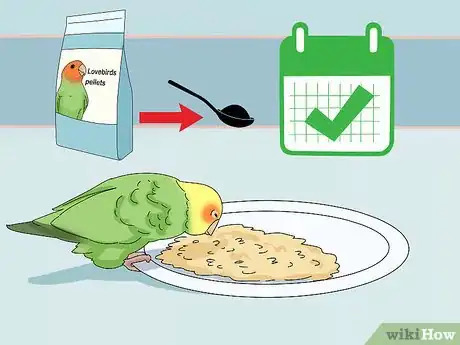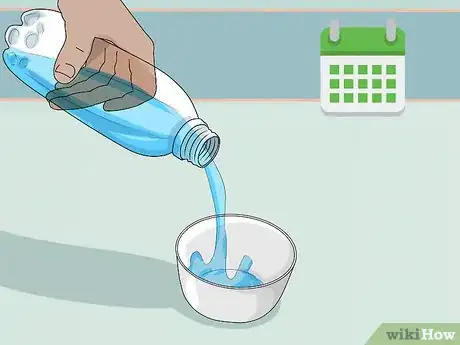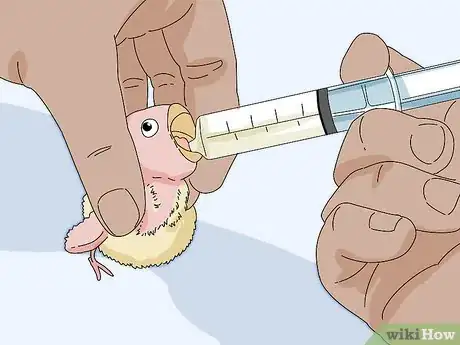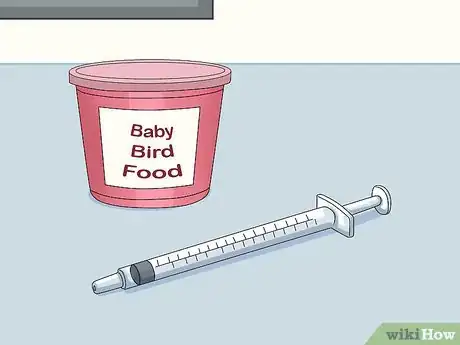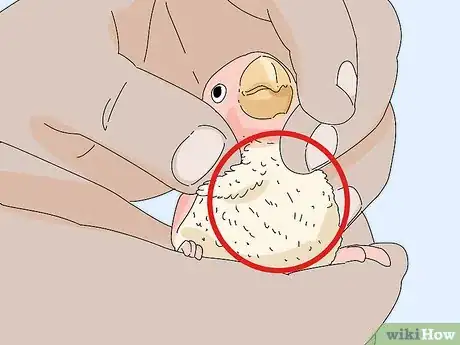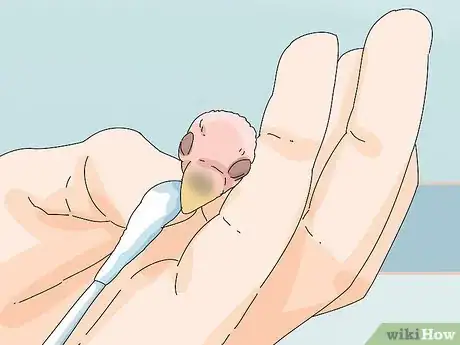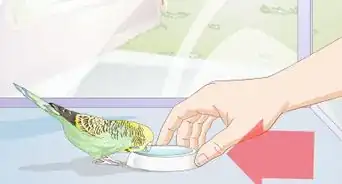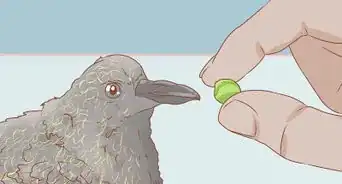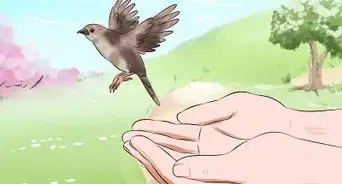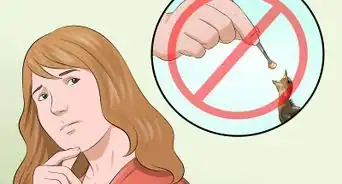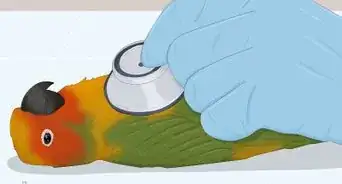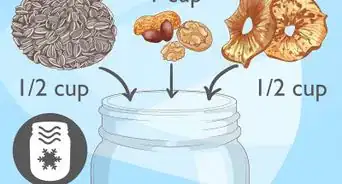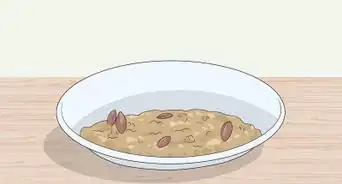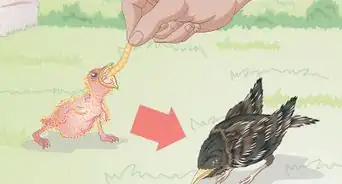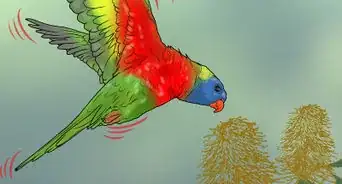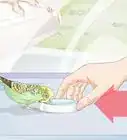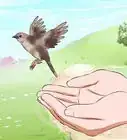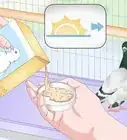This article was co-authored by Deanne Pawlisch, CVT, MA. Deanne Pawlisch is a Certified Veterinary Technician, who does corporate training for veterinary practices and has taught at the NAVTA-approved Veterinary Assistant Program at the Harper College in Illinois and in 2011 was elected to the board of the Veterinary Emergency and Critical Care Foundation. Deanne has been a Board Member of the Veterinary Emergency and Critical Care Foundation in San Antonio, Texas since 2011. She holds a BS in Anthropology from Loyola University and an MA in Anthropology from Northern Illinois University.
wikiHow marks an article as reader-approved once it receives enough positive feedback. In this case, 90% of readers who voted found the article helpful, earning it our reader-approved status.
This article has been viewed 126,091 times.
Lovebirds make great pets, as they are small, active, and have fun personalities. Feeding lovebirds properly will ensure they do well and thrive. Start by choosing a feed that is suitable and healthy for lovebirds. You can then establish a feeding schedule to ensure the lovebirds get enough food and nutrients regularly. Baby lovebirds do well if they are hand-fed, though this can be a time-consuming method.
Steps
Selecting the Feed
-
1Look for pellet food made for lovebirds. Pellet food is the ideal food for lovebirds, as it is formulated to give your birds the nutrients they need. Pick pellet food based on the age of your lovebirds. Make sure the pellet food contains natural ingredients and no additives or preservatives.[1]
- Baby lovebirds will have different pellet food than mature lovebirds. Mature lovebirds are 10 months or older.
- Look for pellet food made for lovebirds at your local pet store or online.
-
2Give the lovebirds fresh vegetables. Lovebirds also do well with supplemental foods in their diet like green lettuce (not iceberg lettuce), spinach, carrots, green peas, endive, tomatoes, parsley, dandelion, radish, cucumber, watercress, broccoli, sprouts, and kale.[2]
- They also do well with wheatgrass, as it is high in chlorophyll.
- Do not give lovebirds avocados, as they are considered toxic to birds.
Advertisement -
3Feed the lovebirds fresh fruit. Lovebirds do well with fresh fruits like pears, bananas, grapes, strawberries, raspberries, apples, oranges, tangerines, kiwi, figs, melon, pitted cherries, and rose hips.[3]
- You can give the lovebirds dried fruits as long as they do not contain sulfites.
-
4Pick a high-quality seed mix to give the bird as a treat. Look for a seed mix that has a wide variety of seeds like millet, canary grass seed, hulled oats, niger seed, flax seed, sunflower seeds, safflower, and grape seeds. The seed mix may also contain soybeans, rye, canary seed, whole brown rice, fennel seed, poppy seed, and sesame seed.[4]
- Because they don’t have much nutritional value for lovebirds, seeds should only be given in very small quantities as treat. Seeds should never be your bird’s sole food source.
- Make sure the seed mix contains a small amount of milo, as this ingredient is often used as a filler.
- Only use fresh seed mix. If the seed mix smells dusty or old, do not give it to your lovebirds.
-
5Offer the lovebirds small nuts. Lovebirds also enjoy shelled and unshelled peanuts, Brazil nuts, acorns, horse chestnuts, and hazelnuts. You can give the lovebirds nuts as a small treat or as a supplement to their regular diet.[5]
-
6Do not give the lovebirds food high in fat, sugar, or preservatives. Lovebirds should not be given fast food or foods high in artificial sugar like candy, ice cream, or sweets. Do not give lovebirds french fries, chips, or deep-fried foods.[6]
- You should also avoid giving lovebirds any foods that contain preservatives or additives.
- Do not give lovebirds alcohol or coffee.
Establishing a Feeding Schedule
-
1Give the lovebirds 1 tablespoon (14 ml) of pellet food a day. Measure out 1 tablespoon of pellet food per bird. 70% of their diet should come from pellet food, while the other 30% should come from fruits and veggies.[7]
- Try to feed the lovebirds at the same time each day. This will ensure they know when they are going to be fed.
-
2Have separate food bowls for each bird. If you have more than one lovebird in a cage, provide one food bowl per bird. This will ensure there is no pecking or fighting over food at mealtime. It will also help you monitor the eating habits of each bird by checking their individual food bowls.[8]
-
3Wash fruits and vegetables before giving them to the lovebirds. Use clean running water to wash all fruits and vegetables. Then, cut them into small pieces and put them in a bowl that is separate from their food bowl. You do not need to peel the fruits or vegetables, as most lovebirds can digest the skin.[9]
- Try to give the lovebirds a variety of different fruits and vegetables. Switch up the types of fruits and vegetables you give to the lovebirds.
- Give them to the lovebirds as small snacks once or twice a day.
-
4Provide clean water for the lovebirds. Lovebirds need lots of fresh water. Change their water daily and refill the water bowl as needed. Make sure their water bowl is full before bed so they have access to fresh water at night.[10]
- Always use water bowls that are shallow so your birds are not at risk of drowning.
Hand-Feeding Baby Lovebirds
-
1Hand-feed baby lovebirds until they are 10 months old. Newborn or baby lovebirds do well with being hand-fed. This can be a time-consuming process but it is ideal if you are raising a baby bird from infancy and want it to do well.[11]
- Often, hand-fed lovebirds grow much stronger and happier than baby lovebirds that are fed from a bowl.
-
2Get a syringe and baby bird food. Look for a small syringe with a small opening. You can find them at local pet stores or online. You will also need baby bird food, which often comes in a powder. [12]
- You will need to mix the powder into boiling water to make the formula for feeding. Follow the instructions on the package for the ratio of water to powder.
-
3Feed the lovebirds slowly. Hold the baby lovebird in one hand with your fingers wrapped lightly around its chest. Fill the syringe with the formula to 6-8ml. Put a small amount on your palm to make sure the formula is not too hot, just warm to the touch. Gently tilt the baby’s head upwards. Place the syringe into the baby’s beak and start feeding it.[13]
- Let the baby bird consume the formula slowly and at its own speed. Do not try to force the baby to eat from the syringe.
-
4Check the baby’s crop for a bulge. The crop is an upper section of the baby bird’s stomach that inflates as it eats. Once it is bulging, you can stop feeding the bird.
- Feed the bird formula every three to four hours. Always feed it until its crop is bulging, never any more than that.
-
5Clean the lovebird’s beak after feeding. Use a clean towel to gently wipe off the lovebird’s beak once it is done eating. Most lovebirds will go to sleep after eating.[14]
References
- ↑ https://vcahospitals.com/know-your-pet/lovebirds-feeding
- ↑ http://petcaretips.net/lovebird-feeding.html
- ↑ http://petcaretips.net/lovebird-feeding.html
- ↑ http://petcaretips.net/lovebird-feeding.html
- ↑ http://animal-world.com/encyclo/birds/lovebirds/LovebirdProfile.htm#Care and feeding
- ↑ http://petcaretips.net/lovebird-feeding.html
- ↑ https://vcahospitals.com/know-your-pet/lovebirds-feeding
- ↑ https://vcahospitals.com/know-your-pet/lovebirds-feeding
- ↑ https://vcahospitals.com/know-your-pet/lovebirds-feeding
About This Article
To feed your lovebird, provide 1 tablespoon of pellet food every day. Try to find high-quality pellets made for lovebirds and which are free from additives and preservatives. Although pellets should make up to 70 percent of your bird’s diet, you should also provide 30 percent fruit and vegetables, such as bananas, apples, carrots, and broccoli, which contain the nutrients it needs. In addition to its normal diet, you can give your lovebird small nuts, like brazil nuts, acorns, and hazelnuts for a treat. For more tips from our Veterinary co-author, including how to hand-feed baby lovebirds, read on!
